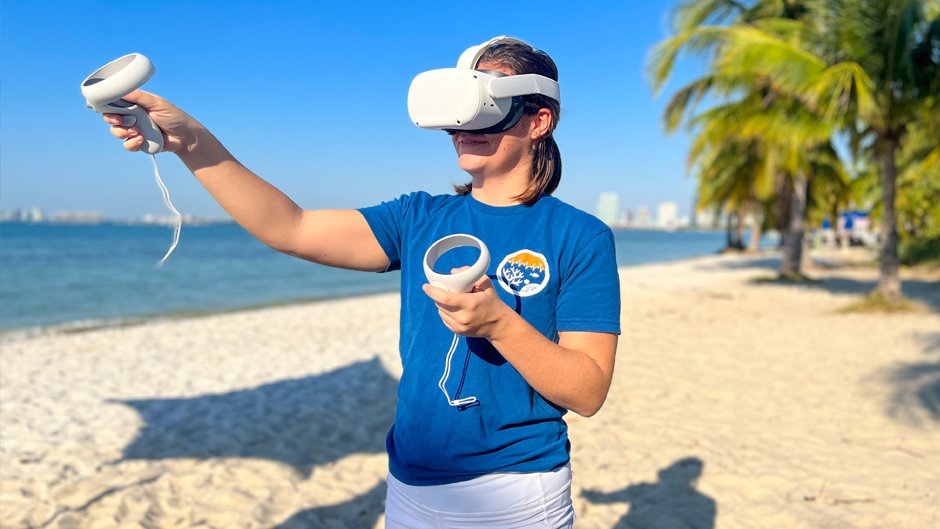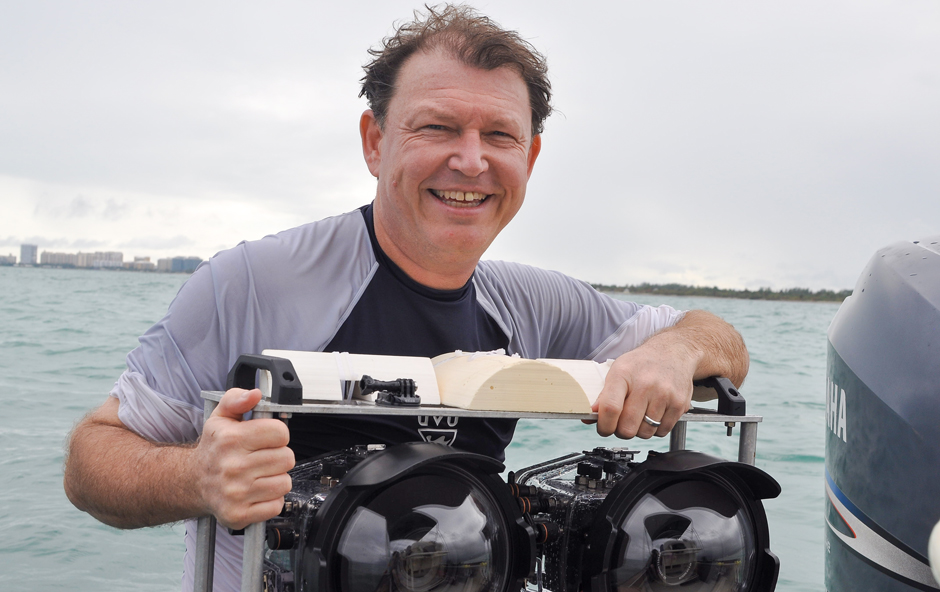Sharing the wonder of coral reefs
(2023)
In News@TheU
By Janette Neuwahl Tannen
August 30, 2023
Two new free VR applications created by faculty teams aim to teach students about coral reefs and let them participate in restoration efforts.

At a time when the future of coral reefs is being threatened by rapidly warming oceans, two new University of Miami virtual reality applications hope to enlighten students about the ocean’s most biodiverse ecosystems.
One application allows students to swim through the ocean and plant coral fragments on a larger reef in an environment similar to what volunteers experience through the Rescue a Reef coral restoration program. The other takes students on a research boat and seaplane to learn about the different formations of coral reefs found across the globe.
Both applications—now available for free download on the app lab for the Meta Quest Headset—were created so that all students, regardless of their swimming ability or location, can experience the natural wonders up close. They were conceived by two faculty teams that received a UMverse Faculty grant, and the experiences were developed in collaboration with Xennial Digital, a Miami-based company focused on extended reality.
“These programs serve not just to enrich classroom learning through innovative technologies but also underscore the University’s dedication to preparing the next generation of students and providing solutions for the effects of climate change,” said Kim Grinfeder, director of the UMverse, formerly known as the University’s XR initiative.
The first application was created by Rescue a Reef, a citizen science program based at the Rosenstiel School of Marine, Atmospheric, and Earth Science, where local divers can outplant coral fragments from the University’s nurseries to help restore local reefs in South Florida. Although the program started in 2015 and has gained many volunteers, program coordinator Dalton Hesley noted that the group’s twice monthly expeditions are often canceled if the weather is not ideal or there is no boat available, and more people want to participate than the program allows. So, they began working to create a virtual experience called How to Rescue a Reef.
“We are really optimistic about how we can use this app in communities and classrooms to raise awareness about the issues coral reefs are facing, as well as the solutions available to recover them,” said Hesley, who is also a senior research associate in the Coral Reef Restoration Lab. “Rescue a Reef has easily reached over 1,000 individuals through our activities and outreach presentations, but our hope is that by making this app free and accessible it turns into tens of thousands.”
With the guidance of Diego Lirman, an associate professor of marine biology and ecology who founded Rescue a Reef, Hesley worked with Xennial to create an immersive experience where anyone can share in reef restoration. In the app, participants board a research boat, don diving gear, and jump into the water. Once under the surface, they can clean the structures where staghorn corals are growing and then use pliers to remove the coral fragments from the floating nurseries. Finally, they can plant the fragments on reefs using a special marine adhesive. All from the comfort of their home or classroom.
A second application, called Virtual Reef Expedition, was developed by physics professor Art Gleason; Sam Purkis, professor and chair of marine geosciences; and Amy Heemsoth, director of education at the Khaled bin Sultan Living Oceans Foundation. It takes students on an international research boat, this time to learn about different types of coral structures found throughout the world’s oceans. They are able to hold and manipulate 3D models of the types of reefs—including atolls, fringing reefs, and barrier reefs—and take notes and draw sketches of the models that show the different coral reef morphologies. Then, participants also board a seaplane and identify the different coral varieties from above that they were learning about on the boat.
“We are really hoping to reach a global audience with this application, and I am interested to see the adoption of this technology in schools,” said Gleason, a marine geoscientist who photographs and creates 3D models of existing reefs to illustrate how they are changing.
Purkis and Gleason partnered with the Khaled Bin Sultan Living Oceans Foundation to create the application since the organization has an existing marine science curriculum on reef types and zonation for middle and high school teachers to use. The foundation also wants to broaden its immersive learning offerings, so they have been a vital part of the development and planning process, Gleason reported, and it even helped the University pilot the app with some high school students.
“It’s clear that this technology really builds student engagement, and the idea that you can have fun too was very effective with that first group,” Gleason said.
Now, Gleason and Purkis want to share Virtual Reef Expedition with local South Florida schools and teachers across the nation. Heemsoth said it could be particularly eye-opening for students living far away from an ocean.
“For kids who have never seen a coral reef, we wanted to take something kind of abstract, like coral reef types and zonation, and make the concept more fun for them,” Heemsoth said. “This is a very different tool in a teacher’s back pocket and shows kids what these different reefs look like in an appealing way.”
The virtual reef models used in the app were based on actual 3D models that Gleason created during the Foundation’s 10-year Global Reef Expedition, where they collected data on reefs throughout the world. The three reef types featured in the app were based on actual coral reef structures in French Polynesia, and the Foundation is looking forward to using the app in South Florida and across the United States.

Download Virtual Reef Expedition.
Download How to Rescue a Reef.